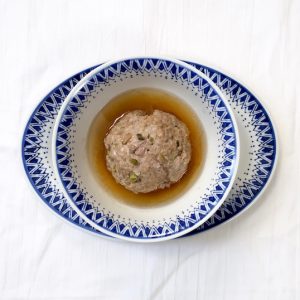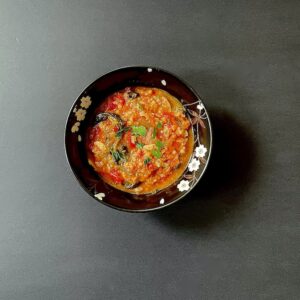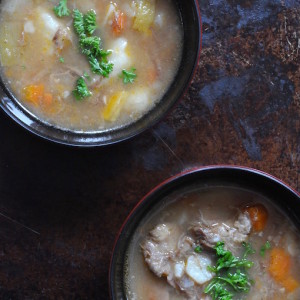Hot and Sour Soup
I cannot lie and say hot and sour soup is an easy prospect. Not that it’s especially difficult. It’s not, exactly. Hot and sour soup is a hassle. Here is a recipe resistant to streamlining, to convenience, to ease. It clings stubbornly to each and every little bowl, to every separate process, to each marination and to every moment you pause, ensuring what you have in your pot is thickening instead of–God forbid–turning into gloop.

I love Chinese food more than any other cuisine. Were it not for my husband, who enjoys the occasional Western meal, I would exist entirely on Chinese food. When I am at death’s door–more often than I let on–I crave Chinese food. When I am unable to keep solid food down–again, more often than I let on–I can eat hot and sour soup.

You know all those jokes about Jews and Chinese food? They’re true. Lacking kitchen space, I hired a carpenter to install shelves in our coat closet, transforming it into a pantry. I promptly filled it with bottles of sesame oil, water chestnuts, bamboo shoots, dried mushrooms, lily bulbs, Chinkiang vinegar, rice wine, and multiple varieties of soy sauce.

Returning to our soup. Preparing Chinese recipes food means lots of small bowls; think mise en place on steroids. If you lack a dishwasher, as I do, disarray can strike rapidly. I recommend cleaning as you go. Whenever I prepare hot and sour soup, mayhem soon erupts. My kitchen is small, and whoever designed it clearly never opened a can.

I tried streamlining the process. I’ve done this with other recipes: condensed bowls, simplified cooking, minimized equipment, you get the drift. Nothing worked here. The soup just got mulish and bricklike.

At its best, hot and sour soup epitomizes balance. The texture is pleasantly smooth without being noticeably thick; the soup’s contents–tofu, either pork or beef, dried mushrooms, scallions–are cut in matching batons. Everything slips gently down the throat. The vinegar will be present, pleasantly sour. The pepper will be tingly, perhaps bringing a slight sheen of sweat to the eater’s brow, but this is not Sichuanese food–ma la–hot and numbing. A fine hot and sour soup is balanced.

As for streamlining, I have come to my senses, abandoning idiotic American notions of saving time or creating convenience. Making a good hot and sour at home requires one’s full attention. It also requires some practice: you may not get it right the first time. Or the second. Keep trying: the results are worthwhile, for the truth is mediocre hot and sour soups abound in commerical joints.
Dishes will be generated. Wash them. The results are worth it. I promise you.

Hot and Sour Soup
with guidance from Fuchsia Dunlop’s Land of Plenty, Grace Young’s The Wisdom of The Chinese Kitchen, and Barbara Tropp’s The Modern Art of Chinese Cooking
Yield: Six Cups/1.4 liters
Preparation time: about an hour to prepare ingredients, less if you’re an accomplished Chinese cook. Once the ingredients are ready, the soup cooks in minutes.
Please read notes, below, before starting to cook.
2 tablespoons dried shiitake mushrooms
2 tablespoons dried lily bulbs
2 tablespoons dried cloud ear mushrooms
2-4 ounces/56-114grams firm tofu
1 teaspoon sesame oil
2 teaspoons soy sauce
1 tablespoon Shaoxing rice wine (or dry sherry)
1 teaspoon white pepper (black if you have no white)
2-6 ounces/56-118grams pork or beef-boneless loin, belly, or chop (flank steak if beef)
Marinade for pork:
-pinch salt, two tablespoons water, 1 tablespoon Shaoxing rice wine
small piece of ginger
2-3 scallions
2-4 garlic cloves, peeled and minced
6 cups/1.4 liters unsalted chicken stock
6-9 tablespoons cornstarch and cold water, kept separated; you may not use all of it
6-9 tablespoons vinegar: ideally Chinkiang or black vinegar. Unseasoned rice vinegar will also work, or even cider vinegar.
More white pepper, to taste
Optional: 1 egg, cracked into a small bowl and blended with a fork
Before starting, have ready a stack of small bowls or dishes, a large cutting board, and a cleaver or other large, sharp, heavy knife. You will also need a medium bowl to marinade the pork and a medium-sized soup bowl.
I like eating hot and sour soup with white rice. If you share my preference, start a pot of rice.
Heat 2 cups/800g water in the microwave. Add the lily bulbs, dried shiitakes, and cloud ear mushrooms to the cup. The bulbs tend to float, so I hold everything down with a clean spoon. Set aside.
Wrap the tofu in a clean dish towel or paper towels and set on a plate to drain. Set aside.
In another small bowl (I know, I know), blend the sesame oil, soy sauce, Shaoxing rice wine, and the white pepper with a fork.
In a bowl large enough to marinate the pork, blend pinch salt, two tablespoons water, and a tablespoon rice wine.
Slice the beef or pork into small pieces–think about eating them with a spoon–and add them to the rice wine mixture. I blend this with clean hands, but a fork works, too.
Slice the tofu into strips and set them in a small bowl or dish.
Slice the ginger, garlic, and scallions and set them in a small bowl or dish. Again, think about eating them with a soup spoon.
Drain the mushrooms. I do this by setting small colander over a bowl and leaving it to drip. If they’re large, you can either cut with a knife, or just scissor them in the colander. Again, think eating with a spoon.
Heat the broth to a simmer. Add the colander of mushrooms, allowing them to cook for a few minutes. Tip in the small bowl of soy sauce, rice wine, and white pepper.
Now wash up so you don’t hate me.
Okay. Add the pork in its marinade. Stir. Add the garlic, ginger, and scallions. Carefully add the tofu; it is fragile.
Wash some dishes.
In a small bowl, blend one tablespoon of cornstarch with one tablespoon cold water. Add to the soup, stirring. Now add one tablespoon vinegar. Taste, taste, taste. Keep stirring up cornstarch/water and adding it to the soup, along with white pepper, until you reach a thickness/flavor balance you like. You may get there with one tablespoon. PLEASE MAKE SURE YOUR PORK IS COOKED BEFORE SAMPLING. Don’t get food poisoning and sue me. You have been warned.
You want a nice velvety texture, with a balance of hot and sour flavors: neither should dominate. Once the soup is balanced, add in the optional egg, if desired: crack it into a small bowl, blend with a fork. Then tip into the soup and stir in one direction until it “threads” into rags.
Serve with rice. Or not.
Although this is not at all traditional, I bought some spicy Japanese rice crackers and sprinkled them over a serving of the soup yesterday, and they were delicious.
Hot and sour soup will keep well, refrigerated, up to five days. It may be frozen up to two months, but I don’t recommend you do so, as soup’s flavor and texture will suffer.
Notes:
Amounts of dried ingredients are suggested; I am running low on dried ingredients due to the pandemic. Hence the disparities between photographs and suggested recipe amounts.
Dried shiitake mushrooms are easily found in most Western markets, as are cloud ears. Cloud ears may be labeled “Black Fungus” and are sold in various sizes. Smaller are better, but if the larger are all you can buy, go with it.
I’ve never seen dried lily bulbs for sale in Western markets. Order online, or buy them in your local Chinese market.
Black vinegar is becoming more widely available in Western markets. It is also sold as “diluted black vinegar.” You can use this, Chinkiang Vinegar (my preference), unseasoned rice wine vinegar, or even cider vinegar.
Most recipes use a scant amount of protein–4-6 ounces. This is up to you.
Some hot and sour recipes marinate meat; others eschew this step. The late, great Barbara Tropp, writing in The Modern Art Of Chinese Cooking, writes:
“Marinating the meat, for even five minutes, changes its texture remarkably. It becomes plush and slippery on account of the cornstarch and oil, which creates an impenetrable flavor seal for the beef when it enters the hot stock.”
Some recipes include egg in the soup, others do not. To add egg, just before serving, crack one egg into a small bowl. Blend vigorously with fork. Tip into the soup pot, stir briskly in one direction so it threads into “rags.”
Bamboo shoots are traditionally included in hot and sour soup; they do not appear here as I had run out.
A final note about tofu: unfinished portions may be frozen. Slice into squares, lay flat on a tray, and open freeze overnight. Transfer to sealed container or ziploc freezer bag. The texture will change, but the tofu will be suitable for soups or stews. I learned this trick from Naomi Duguid and Jeffrey Alford’s Seductions of Rice.





